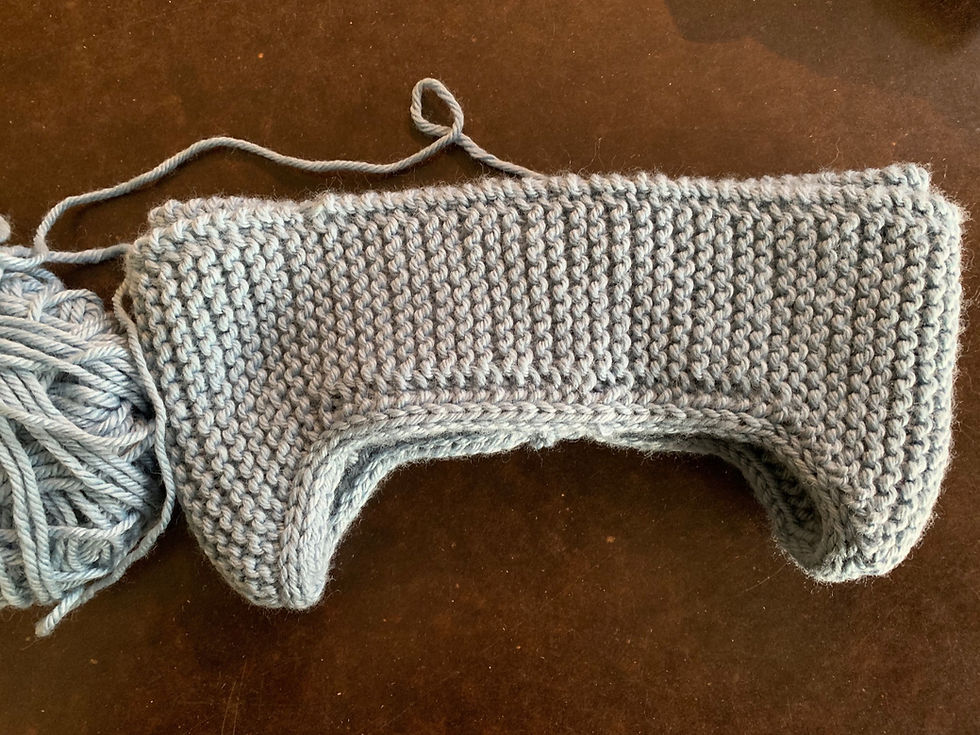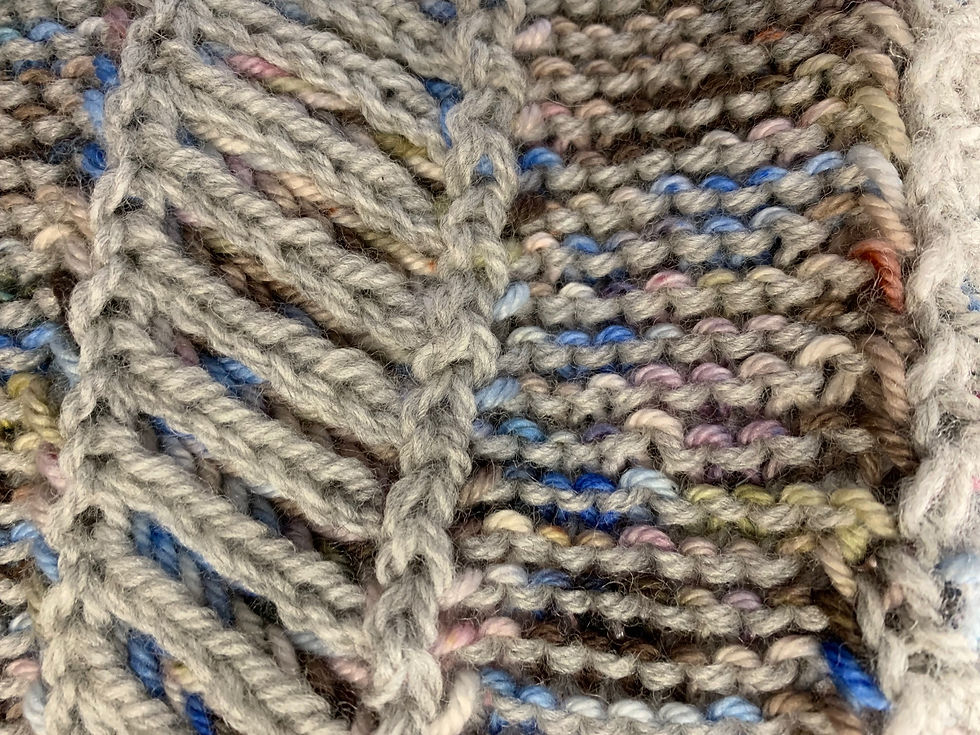Ah, Sweet Mystery of Life
- Ashley Lambert-Maberly
- May 8, 2019
- 6 min read
Sometimes in life one encounters a mystery. It could be as deep and complex as your loved one's ghastly taste in music, as sweet and simple as "how do they get the caramel in a caramilk bar," or as agonizingly difficult as the form I have to fill out to get reimbursed for $7 for parking at a work-related event (I earn a good living, so I estimate by my hourly rate that my employer pays me about $50 to fill out the form so I can get reimbursed for $7).
Oftentimes the mystery is a knitting pattern. It tells you to do stuff, and you stare at it blankly, wondering what on earth it means (especially if you're me, and have little common sense). This is an especially pernicious feeling if one reads ahead—a reasonable thing to do, to make sure you won't invest hours into a project only to be derailed by step 9 of 10. One can turn to Ravelry.com's pattern forums, where one is likely to be told "just knit as instructed, step-by-step, and it'll become clear." And you know what? Usually they're right, and it all works out. And if you're still stuck at step 9, post again, and someone will sort it out for you.
So I'm wading in where young Uncle Stashley once feared to tread: I'm knitting patterns that confuse me whilst reading them, in the hope that it'll all make sense if I follow the steps in sequence. And I'm lovin' it!
The most confusing instructions, for me, tend to involve construction methods. If the instructions describe a stitch pattern it might be involved, but it's not usually confusing (e.g. "knit 2, purl 1, yarnover, knit 2 together, purl3, repeat"). But as one knits more and more, one gets used to basic construction methods, and deviating from them induces a temporary panic.
Take a hat, for example. It's probably a beanie, or (if you're Canadian) a tuque. I know how to make these (it was once a mystery, but no longer!) You cast on sufficient stitches onto small (16") circular needles (or longer, if magic looping, or use dpns, yada yada yada). You join in the round and keep knitting (probably a ribbing pattern, to begin with). Later you might switch it up to introduce other colours, or a new stitch pattern, or cables, but you're still knitting in the round on your small circular needles. At some point you decide it's long enough and you start to decrease. When you can't decrease any more because you're down to almost no stitches, you stick your yarn through a tapestry needle and shove it through the remaining stitches, pull it tight, weave in the end, and you're done. A hat. Simple.
So picture my surprise when my return-from-European-vacation hat began with knitting a garter stitch band, sideways!
Photo below, of band after it was finished:

What's that ridge in the middle? I'm glad you asked. The band was actually mostly garter, but you switch it up in the center by knitting 3 on the right side, and slipping 3 on the wrong side (with yarn in front, i.e. on the wrong side). It creates a long band that wants to fold in the middle, wrong side in.!
(This is especially useful when you actually want your band to fold in the middle, wrong side in, which we do in this case—the next photo shows it folded up).
Let me introduce you to the joys of the 1898 Hat, by designer Kristine Byrnes, which won the Seamen's Church Institute's contest for designing a knitting pattern for a hat with ear flaps.
With a squishy sideways garter band that folds in half, you know that you pretty much can't get anything warmer or more comfortable for around your face. And it gets better! Because Kristine has you make ear flaps by having you increase (and later decrease) on either side of the central ridge, at what-would-be opposite sides of the band once it's joined together in the round. This makes earflaps that actually want to curve in around your ears!

That's the weird/exciting/innovative bit out of the way. After the band is built, you pick up stitches and knit a normal beanie/tuque above it. (You should give it a go--it's a free pattern, and it's a really good one!) I decided to have fun with mosaic knitting and randomly combined colours and slipped stitches. BTW, it's too grey above, and the right colours below—different times of day and lighting make such a difference.

And it looks good on me (I think).

But I will have to wait a few months before getting a chance to try it out for reals—the downside of knitting winter hats in April/May.
My next ambitious bit of exciting construction is the Arbow Cowlyoke by Stephen West—you'll remember it as the knitting begun in Amsterdam, with West's yarn from West's shop for West's pattern:

This is the pattern that alternates (in the cowl section) garter stitch with Brioche stitch. And the more I think about it, the more I think it shouldn't work ... and yet it does. My thinking goes somewhat like this: To do 2-colour brioche, each round/row uses a strand of Yarn A, and a strand of Yarn B. To do garter, each round/row uses either a strand of Yarn A or a strand of Yarn B. Let me reverse that: if you knit two strands in brioche, you create only 1 round or row. But if you knit 2 strands in garter, you create 2 rounds or rows. In other words, as you carry on with your knitting, your garter panel should get taller and taller and taller relative to the brioche, because the garter panel contains more rounds/rows. And yet, it doesn't.
At first I thought "Oh, how clever, he's using increases and decreases in the brioche section that end up angling the brioche stitches" (you can see in the image, they're leaning so much they're almost horizontal) but then I realised that would exacerbate the problem, not fix it—if garter is taller than brioche, you need to angle the garter sections, not the brioche sections! So I still don't understand what Mr. West has done here, but it works. The folk on Ravelry would have suggested I just keep knitting, and they would have been right.
I am, however, very confused by the final steps: I am to knit about 14 rows, then "fold hem in half" and pick up some stitches and knit them together and bind off ... but I don't know whether to fold in half outwardly, or inwardly. Off to Ravelry* to find out!
*Editorial Update: Ravelry says it's wrong sides together, like a sewn hem would be.
If It's Saturday, This Must Be Leiden
More yarn store adventures ahead (skip to the section on Leiden)!
For those of you who enjoyed hearing about my travels, after Brussels we returned to the Netherlands where we visited three major gardens, a theme park, Den Bosch, The Hague, and Leiden, which I've managed to distill into barely 2 photos per place.
The Gardens of Appeltern

Above, Rheal relaxing by the sluice; below the "Protest Tree." The Gardens of Appeltern are 200 display gardens featuring different designs applicable to one's own front or back yard (Protest Tree excepted).

Keukenhof

Keukenhof is about 80 acres of springs bulbs and is only open March to May. Above, a temporary exhibit exemplifying "Flower Power," their theme this year, and below, intriguing statuary next to a lovely display of blooms.

Hortus Botanicus Leiden

The Netherlands' oldest botanical garden and one of the oldest in the world (50 years younger than the winner).

Efteling

It's an absolutely charming theme park that I'd first visited 50 years ago, and now is just as charming but with many, many, many more thrill rides (I think it originally had none, just sweet, gentle walk-through attractions, most of which are still there).

Den Bosch

So clean, so pretty. It's the largest town in the area where my Dutch relatives live.
The Hague

Loved the Hague. The Centre is so picturesque, and filled with amazing museums and stunning Art Nouveau architecture.

Leiden

Just a day trip for us, so we could check out Hortus Botanicus. It's really a charming little town.

With, again, some fabulous Art Nouveau:

And a yarn store: a Hand + Werk + Shop, which may or may not also be called Ribbels, which may or may not also be called Meet and Make. Honestly, I'm just lucky I was able to find it after all the confusion.

It's a lovely shop that's impossible to buy in. It famously has its yarn organized by colour. By colour! Not by brand, or weight, but by colour. Yikes. (If you're not sure why this would be tricky, imagine a book store organizing its books by jacket colour!) Colour is generally the last thing one decides upon, you go in knowing "I need 3 skeins of a sturdy DK-weight yarn, hopefully wool with a bit of silk or nylon in it for some strength" and then after being guided to the right yarn(s) you pick your colours.

(I bought one skein of something—trying to buy two skeins the same of something in different colours would have killed me).
Off the Needles
1898 Hat (as discussed above)
On the Needles (and actively being worked on):
Arbor Cowlyoke (in the final hem section!)
Itineris Shawl (I'll pretend it's a scarf. I'm midway through the fourth repeat)
A swatch of stockinette in white worsted (third of three needle sizes) for my Master Knitting Course
Caldwell Vest (halfway through armhole shaping on the back)
Persian Dreams Blanket (round 6 of Hexagon 9)






Comments